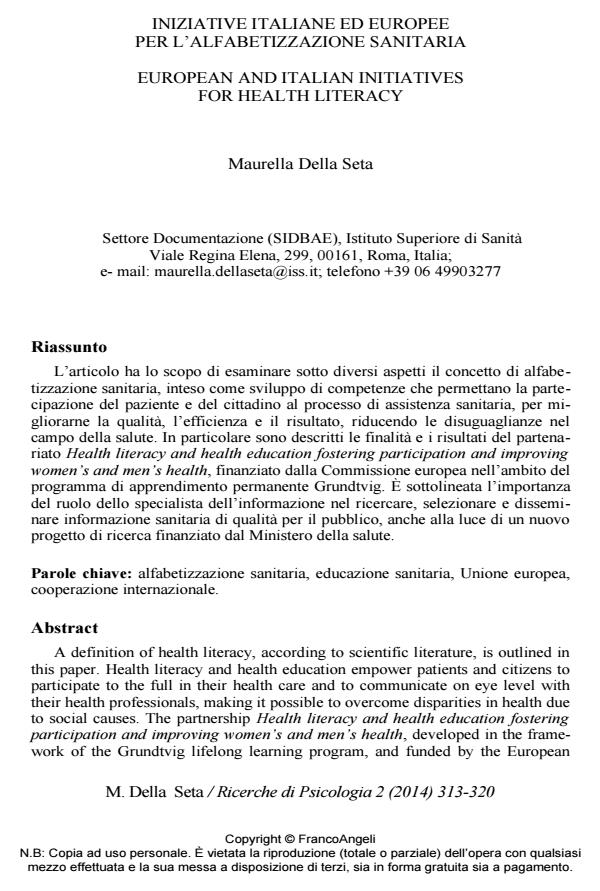European and italian initiatives for health literacy
Journal title RICERCHE DI PSICOLOGIA
Author/s Maurella Della Seta
Publishing Year 2015 Issue 2014/2 Language Italian
Pages 8 P. 313-320 File size 177 KB
DOI 10.3280/RIP2014-002007
DOI is like a bar code for intellectual property: to have more infomation
click here
Below, you can see the article first page
If you want to buy this article in PDF format, you can do it, following the instructions to buy download credits

FrancoAngeli is member of Publishers International Linking Association, Inc (PILA), a not-for-profit association which run the CrossRef service enabling links to and from online scholarly content.
A definition of health literacy, according to scientific literature, is outlined in this paper. Health literacy and health education empower patients and citizens to participate to the full in their health care and to communicate on eye level with their health professionals, making it possible to overcome disparities in health due to social causes. The partnership Health literacy and health education fostering participation and improving women’s and men’s health, developed in the framework of the Grundtvig lifelong learning program, and funded by the European commission, is analyzed in detail. Role of the information specialist in searching, validating and disseminating health information for the general public is examined, in the light of a project funded by the Italian Ministry of Health.
Keywords: Health literacy, health education, European union, international cooperation.
- Edwards, M., et al. (2012). The development of health literacy in patients with a long-term health condition: the health literacy pathway model. BMC Public Health, 12, 130. DOI: 10.1186/1471-2458-12-130
- Falcone, M.A. et al. (2013). Un partenariato europeo per l’alfabetizzazione sanitaria. Notiziario Istituto Superiore di Sanità, 26(7-8), 19-21.
- McCaffery, K.J., et al. (2013). Addressing health literacy in patient decision aids. BMC Medical Informatics and Decision Making, 13(Suppl 2), S10. DOI: 10.1186/1472-6947-13-S2-S10
- Nutbeam, D. (2000). Health literacy as a public goal: a challenge for contemporary health education and communication strategies into the 21st century. Health Promotion International, 15(3), 259-267. DOI: 10.1093/heapro/15.3.259
- Pomerantz, K.L., et al. (2010). Connecting for health literacy: health information partners. Health Promotion and Practice, 11, 79.
- Sorensen, K., et al. (2012). Health literacy and public health: a systematic review and integration of definitions and models. BMC Public Health, 12, 80. DOI: 10.1186/1471-2458-12-80
- Sykes, S., et al. (2013).Understanding critical health literacy: a concept analysis. BMC Public Health, 13, 150. DOI: 10.1186/1471-2458-13-150
- Tones K. (2002). Health literacy: new wine in old bottles. Health Education Research, 17, 187-189. DOI: 10.1093/her/17.3.287
- US Department of Health and Human Services (2000). Healthy people 2010, understanding and improving health (2nd ed). Washington, DC: U.S. Government Printing Office.
Maurella Della Seta, Iniziative italiane ed europee per l’alfabetizzazione sanitaria in "RICERCHE DI PSICOLOGIA " 2/2014, pp 313-320, DOI: 10.3280/RIP2014-002007